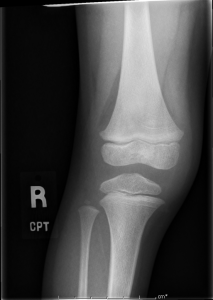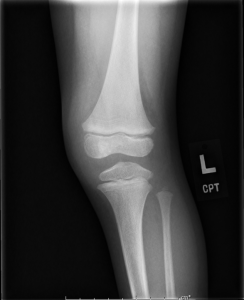Hot Seat #53: 3 yo M p/w b/l knee swelling and refusal to walk
Posted on: March 19, 2015, by : Jaclyn Kline
by Jaclyn Kline, Children’s National
with Mike Quinn, Children’s National
The Case
Previously healthy boy presents with refusal to walk today, and maternal report that both of his knees appear swollen. Per report, 4 days ago, he was limping and refusing to walk when he was at his father’s house, only his mother is present today, and does not know which leg he was favoring then. In the interim, he had no symptoms and was walking and playing as usual. Mother also reports another similar instance about 2 mo ago, but the symptoms completely resolved, and she did not seek medical care.
ROS: mother denies fever, recent travel, known insect/tick exposure (child lives in DC), vomiting, diarrhea, cough or rash. She does endorse some rhinorrhea, which she attributes to it being winter time.
PE: T-38.0, HR-122, BP-109/55, RR-30, 100% on room air
General-Alert, interacting
HEENT-WNL, NL OP exam
CV-regular rate and rhythm, no murmur, no gallop, normal peripheral perfusion
Respiratory-lungs clear to auscultation, breath sounds are equal, symmetric chest expansion
Gastrointestinal-soft, NTNT, no organomegaly, NABS
Musculoskeletal- Bilateral knee edema and erythema with warmth, left more than right, child complains of pain with palpation. No TTP over hip joints or ankle joints. Normal ROM bilat hip joints. Flexes the knees bilaterally to 90 degrees refuses further flexion d/t pain. extends knees 180 deg bilaterally. Initially does not stand up straight but does after prompting. Will walk after much prompting with only 1-2 steps, then asks to be picked up.
Neurological-No focal neurologic deficits, face symmetric, tongue midline, full ROM at ankles bilaterally with 5/5 strength, CN 2-12 WNL
Initial Workup
You order CBC, ESR, CRP, Lyme titers, blood culture and get bilateral knee x-rays.
Questions for you:
Re-examination
Your labs and xray come back:
WBC-9.17, Hgb-10.3, Hct-31.1, Plt-395, 47% neutrophils, 35% lymphocytes, 13% monocytes, 5% reactive lymphocytes
ESR-43, CRP-6.88, Lyme Titers and Blood culture-pending


The patient’s clinical status remains unchanged. He is in no pain when lying still, but refuses to walk d/t pain, despite ibuprofen.
How would you approach this case? Please share your opinions by clicking on “What do you think?” below.

I think you need a better exam here. You need to decide clinically if the patient has knee effusions, or arthralgias or cellulitis/soft-tissue infection. i wouldn’t use the word “edema” to describe a knee. If you lay the legs flat, you should see fluid accumulating in the supra-patellar pouch if there is an effusion. Effusions are bouncy and can often see a fluid wave unless really obese. You don’t need US or XR for this when talking about the knee (but do for the hip!). Althouth lateral XRs can show displacement of the patella indicative of an effusion. I personally think warmth is an unhelpful clinical sign. Every effusion is a tad warm but that doesn’t mean septic. And warm is different from HOT. The effusions that are typical with Lyme or HSP shouldnt’ be painful to palpation but should limit ROM. but i admit this is hard in a 3yo (although better than a 2yo !). Redness and TTP would be unusual in an post-infectious or rheumatologic arthritis of a big joint. You also want to elicit for tenderness of surrounding bone (e.g., distal femur) which is classic for an osteo.
If this is one joint, i think the question is whether it’s worth doing arthrocentesis on a pretty unremarkable sounding joint because of a barely-fever and elevated inflammatory markers. if it was one joint and this is acute, i probably would take fluid out and if negative admit for arrange an MRI for eval of osteomyelitis (with transudative effusion). because of the fever (+/- pain with palpation).
If it’s two joints, that sorta tells me that it’s not a septic joint or osteo. but you need to convince yourself it’s really two joints and not just one joint affected and the other compensating. but if it’s truly two joints, i would probably add some post-streptococcal titers (anti-DNAse B /. ASO) and arrange outpatient follow-up. And defer treatment for “lyme” until ELISA is back. in older kids, >8yo doxy-range, i don’t mind treating for presumed lyme pending ELISA if afebrile and monoarticular arthritis of knee.
close follow-up is key for most of these. don’t miss an osteo or a septic joint, but the majority of these (in our area) are either Lyme or post-infectious or some other yet-to-be-identified chronic disease (IBD, rheum, etc).
I’m falling back on my “I trained in general emergency medicine” roots here, but if I were staffing a resident on this case, let’s not limit the differential.. Kids can have hyperuricemia too, and certainly JRA or malignancies could present this way. Dave mentions this too…. he is so thorough.
We have seen a lot of Lyme effusions over our way, and thanks to ultrasound knees are even easier to tap than they were before. Definitely a procedure to practice.
Pending that you followed Dave’s instructions and have ensured it’s bilateral knee local involvement, my thoughts would be that: fever, 2 knees -> Rheum or Lyme (or a very unlucky child).
I was going to say that I would tap the knee (or have ortho do it) But upon a quick up to date review it says: “Analysis of synovial fluid by ELISA or Western blot will also demonstrate B. burgdorferi reactivity, but such testing is unnecessary, since it is neither more sensitive nor more specific than serum analysis.”. So that’s not helpful. And I believe it’s the same for rheum dis.
I would talk to rheum to see what further labs they would like: ANA, dsDNA etc…
Typically such a work up could be done as an outpatient. But if a child can’t walk, unless the parents have really good follow up and I was able to talk to the PMD, I would prefer to admit the child for further evaluation and treatment, and to be discharged with at least some basic function back- which includes walking. (Note, not every child who can’t walk needs admission.e.g fracture that is treated in the ED)
Categories:
Infection: the biggest concern is septic joint. Using the Kocher criteria and acknowledging their limitations (retrospectively-derived parameters looking at the hip and not knee joint), the child could meet criteria for a knee tap, whether by ED provider or by Ortho colleague. Less urgent is non-bacterial infection. And in studies of knee swelling in areas of endemic Lyme, Lyme infection is the more common. So send Lyme titers and treat if he is going home.
Post-infectious: ask about viral illness or Strep throat in the past 2-4 weeks. Send labs for Strep, anti-DNAse B and ASO titers. Viral titers numerous and not indicated unless there is more complexity to the presentation.
Autoimmune: post-infectious falls into this, but thinking more of JIA/SLE. This seems like a good history for JIA, missing of course chronicity of symptoms, since the child has only had symptoms for 4 days. This would not be diagnosed on this visit, nor does it need to be.
Trauma or boney malignancy: labs and Xrays helpful in reducing concern.
Next steps in ED: not walking despite NSAIDs would push me more towards arthrocentesis. Then need results- if low wbc count and negative gram stain and child still won’t walk, I would lean towards admission with good point made above about considering MRI for osteo of nearby femur or tibia. If improved, would discharge home after discussion with the PMD about following the child closely with review of Lyme labs and concern for pauciarticular JIA.
Just two throw my 2 cents in–I would not tap the knees of this child unless I thought there would be significant reduction in pain. Bilateral knee swelling that is recurring is most likely JIA/other rheumatologic process. I think bilateral septic joints that are resolved and came back 2 months later is so low on my differential that I would not subject this patient to a joint tap.